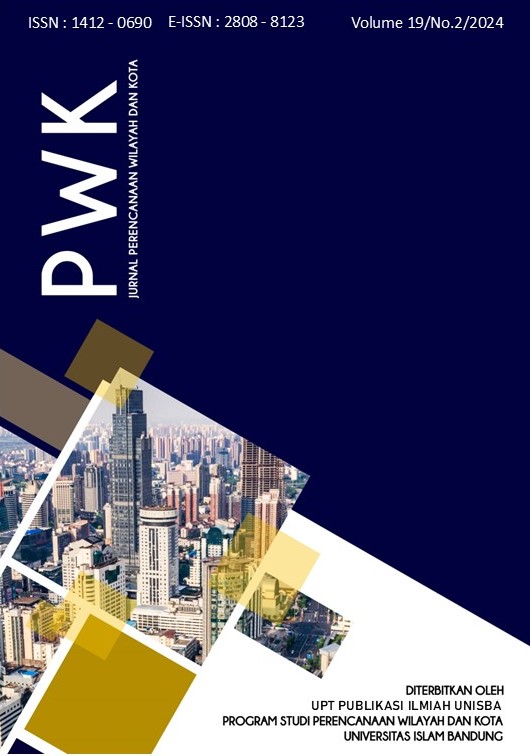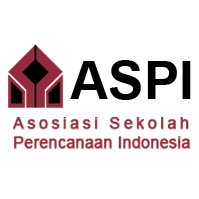Evaluation of the KOTAKU (Kota Tanpa Kumuh) Program in Babakan Surabaya Subdistrict, Kiaracondong District, Bandung City
DOI:
https://doi.org/10.29313/jpwk.v19i2.4220Keywords:
Slum Settlements, Evaluation, Slum Level, KOTAKU ProgramAbstract
Rapid urbanization has driven the growth of slum areas in urban regions, including Babakan Surabaya Subdistrict, Kiaracondong District, Bandung City, which was prioritized for intervention through the KOTAKU program in Bandung City’s RP2KPKP 2017–2021. This study evaluates the program's achievements in Babakan Surabaya, Kiaracondong, which had the largest slum area in 2017. Using a summative evaluation method and a mixed-methods approach, data were collected through a checklist based on slum area criteria from the Ministry of Public Works and Housing's handbook, community perception questionnaires, and literature review. The analysis compared existing conditions with the criteria mentioned above and analyzed community perceptions. Road access, clean water provision, and wastewater management were deemed successful, while drainage and waste management were less successful, and fire protection was unsuccessful. Community satisfaction correlated with the assessment criteria, with high satisfaction for clean water and low satisfaction for fire protection. Slum levels will decrease from moderate to light by 2024. The KOTAKU program requires improvements, especially in fire protection.
References
Arikunto, S. (2002). Research Procedures: A Practical Approach. Jakarta: Rineka Cipta.
Amiany. (2017). Physique Management of Slum Settlements in Kapuas City. Jurnal Teknika, Vol. 1, 70–77.
Djami, R. S. P. (2017). The Effect of High Population Density on Children's Spatial Behavior in Kampung Iromejan, Yogyakarta. Master’s thesis, UAJY. Available at https://e-journal.uajy.ac.id/14040/.
Hidayati, I. (2021). Urbanization and Social Impacts in Major Cities: A Review. Vol. 7 No. 2 (2021): Jurnal Ilmiah Ilmu Sosial. Available at https://doi.org/10.23887/jiis.v7i2.40517.
Irham, A. R., & Putri, R. M. (2023). The Impact of Population Density on the Human Development Index in Lampung Province. Jurnal Media Komunikasi Geografi, Vol. 24 No. 1 (2023). Available at https://ejournal.undiksha.ac.id/index.php/MKG/article/view/60261.
Janus, M., & Brinkman, S. (2010). International Encyclopedia of Education (Third Edition). Available at https://www.sciencedirect.com/topics/social-sciences/summative-evaluation.
Kasiram, M. (2008). Quantitative-Qualitative Research Methods. Malang: UIN Malang Press.
Ministry of Public Works and Housing. (2014). Regulation of the Minister of Public Works and Housing No.1/Prt/M/2014 on Minimum Service Standards in Public Works and Spatial Planning. Available at https://peraturan.bpk.go.id/Details/128202/permen-pupr-no-01-prtm2014-tahun-2014.
Kusumawardhani, V., Sutjahjo, S. H., & Dewi, I. K. (2016). Provision of Housing and Basic Infrastructure in Urban Slum Settlements (Case Study in Bandung City). Jurnal Arsitektur NALARs, Vol. 15 No. 1, January 2016:13-24. Available at https://jurnal.umj.ac.id/index.php/nalars/article/view/551.
Liandri, B., & Suheri, T. (2019). Evaluation of the KOTAKU (Kota Tanpa Kumuh) Program in Lebakgede Sub-district, Coblong District, Bandung City. Jurnal Wilayah dan Kota, 6(2), 78–86.
Li, J., Li, G., Li, J., & Liu, A. (2021). Integrating Conformance and Performance for the Evaluation of Urban Planning Implementation from a Goal-Oriented Perspective. EPB: Urban Analytics and City Science, 0(0), 1–17.
Mantra, I. B. (2007). General Demographics. Yogyakarta: Pustaka Pelajar Offset.
Central Government. (2011). Law No. 1 of 2011 on Housing and Settlement Areas. Available at https://peraturan.bpk.go.id/Details/39128/uu-no-1-tahun-2011.
Pokja PKP Bandung City. (2017). RP2KPKP Bandung City 2017–2021. Ministry of Public Works and Housing. Available at https://epkp.ciptakarya.pu.go.id/produk-hukum/dokumen-kumuh/rp2kpkp.
Rubianti, D. R., Wahyuningrat, & Simin. (2020). Implementation of the Kota Tanpa Kumuh (KOTAKU) Program in Sokaraja Kidul Village. Jurnal Ilmu Administrasi Negara (Asian), 8(1), 33–46.
Sabitha, F. A. (2022). Analysis of the Impact of Urbanization Rates on the Availability of Residential Land in Surabaya City. Jurnal Lemhannas RI, 10(1), 19–26. Available at https://doi.org/10.55960/jlri.v10i1.268.
Safarina, T. S., & Damayanti, V. (2023). Strategies for Handling Slum Settlements in Cibangkong Sub-district Based on the Concept of Livable Settlement. Jurnal Riset Perencanaan Wilayah dan Kota (JRPWK), 3(1), 55–64. Available at https://journals.unisba.ac.id/index.php/JRPWK/article/view/1956.
Sarwono, S. W. (1992). Environmental Psychology. Jakarta: PT. Grasindo.
Sofaer, S. (1999). Qualitative Methods: What Are They and Why Use Them? Health Services Research, 34(5 Pt 2), 1101.
Sudjana, N., & Ibrahim, I. (2007). Research and Evaluation in Education. Bandung: Sinar Baru Algensindo.
Yulia, F., Istijono, B., & Hidayat, B. (2024). Effectiveness of the Kota Tanpa Kumuh (KOTAKU) Program in Addressing Slum Settlements in Padang City (Case Study: Binuang Kampung Dalam Sub-district, Pauh District). Jurnal Niara, 16(3), 642–651.















